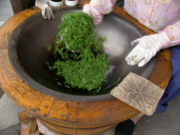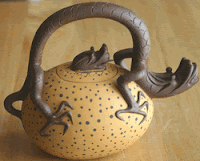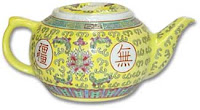 To enjoy the most wonderful aspects of truffles, you must eat fresh, uncooked specimens shortly after they have been harvested. The strength of the truffle flavor decreases rapidly with time, and much of it is lost before some truffles ever reach the market. However lovers of these earthly gems, freshly harvested truffles can be purchased in advance from most gourmet specialty stores and if you are friends with a chef, some will order them for you if you ask nicely. Wholesalers cover them with rice on restaurant serving trays in a refrigerated room as soon as they arrive. The next day they are delivered to the store where your order was placed. When you spend as much money as will be needed for such a culinary indulgence, use care to assure that you get truly fresh truffles.
To enjoy the most wonderful aspects of truffles, you must eat fresh, uncooked specimens shortly after they have been harvested. The strength of the truffle flavor decreases rapidly with time, and much of it is lost before some truffles ever reach the market. However lovers of these earthly gems, freshly harvested truffles can be purchased in advance from most gourmet specialty stores and if you are friends with a chef, some will order them for you if you ask nicely. Wholesalers cover them with rice on restaurant serving trays in a refrigerated room as soon as they arrive. The next day they are delivered to the store where your order was placed. When you spend as much money as will be needed for such a culinary indulgence, use care to assure that you get truly fresh truffles.The term "truffle" as commonly used, refers to members of the genera Tuber and Terfezia. Truffles are hypogeous (underground) versions of mushrooms. They don't form a prominent stem and their spore-bearing surfaces are enclosed. They rely on animals eating them (mycophagy) to distribute their spores, instead of air currents like mushrooms. They resemble small potatoes, and often between the size of a marble and a golf ball. There are hundreds of different kinds of truffles and while none are known to be poisonous, only a few of them are considered to be delicacies by humans. Truffles (and mushrooms) are only the "fruit" of the fungus (like an apple to an apple tree); the main perennial fungal body exists as a web of filamentous hyphae in the soil. All of the truffle fungi form mycorrhizae with the roots of trees, and are essential to the trees' ability to acquire nutrients. The below ground fruiting habit of truffles is thought to be an adaptation to forest fires or dry or frosty periods, in which above ground mushrooms are more vulnerable.There are many other kinds of subterranean fungi, "false truffles," which outwardly resemble the ones we eat, and they are actually far more common than the ones collected for food, with some poisonous as well. Truffles are round, warty, and irregular in shape and vary from the size of a walnut to that of a man's fist. The season for most truffles falls between September and May.
The mention of truffles conjures up images of the expensive French black truffle (Tuber melanosporum) from the Périgord region of southwest France, used in making pâté de foie gras, or the renowned odorous white truffle (Tuber magnatum) of Alba, in the Piedmont district of Italy. Since the times of the Greeks and Romans these fungi have been used in Europe as delicacies, as aphrodisiacs, and as medicines. They are among the most expensive of the world's natural foods, often commanding as much as $1,950 per pound.
The Tuber magnatum truffles sell between $2,200 and $1,000 US per pound. Giancarlo Zigante (pictured above) and his dog Diana found one of the largest truffles in the world near Buje, Croatia. The truffle weighed 1.31 kilograms (2.9 lb) and has entered the Guinness Book of Records.
The record price paid for a single white truffle was set in December 2007, when Macau casino owner Stanley Ho paid US $330,000 (£165,000) for a specimen weighing 1.5 kilograms (3.3 lb), discovered by Luciano Savini and his dog Rocco. One of the largest truffles found in decades, it was unearthed near Pisa and sold at an auction held simultaneously in Macau, Hong Kong and Florence.
Truffles have been found in Europe, Asia, North Africa, and North America, but only three species are commercially important.
 Truffles are harvested with the aid of female pigs or truffle dogs, which are able to detect the strong smell of mature truffles underneath the surface of the ground. The use of pigs is risky, though, because of their natural tendency to eat any remotely edible thing. For this reason, dogs have been trained to dig into the ground wherever they find these odors, and they willingly exchange their truffle for a piece of bread and a pat on the head. Not a bad trade for the truffle hunter! Some truffle merchants dig for their prizes themselves when they see truffle
Truffles are harvested with the aid of female pigs or truffle dogs, which are able to detect the strong smell of mature truffles underneath the surface of the ground. The use of pigs is risky, though, because of their natural tendency to eat any remotely edible thing. For this reason, dogs have been trained to dig into the ground wherever they find these odors, and they willingly exchange their truffle for a piece of bread and a pat on the head. Not a bad trade for the truffle hunter! Some truffle merchants dig for their prizes themselves when they see truffle  flies hovering around the base of a tree. Once discovered, truffles can be collected in subsequent years at the same site.
flies hovering around the base of a tree. Once discovered, truffles can be collected in subsequent years at the same site.
So what does a truffle taste like?
The flavor of the truffle is directly related to its aroma. The chemicals necessary for the odor to develop are created only after the spores are mature enough for release, so they must be collected at the proper time or they will have little taste. This is the only sure indication that the mushrooms are ready to be harvested. This is the very reason why animals have proven to be the best means of assuring that the fungi collected will be flavorful. Gaining in popularity and comparing favorably with the Italian truffle, the Oregon truffle is harvested in sufficient quantity to support commercial sales. Although the Oregon truffle industry is in its infancy, it commands as much as $150 per pound for its truffles. James Beard claimed that the mature Oregon white truffle could be substituted for European varieties.
Originally found in California, the Oregon truffle grows in association with Douglas fir trees and is a major food source for many small rodents and other mammals. These underground fungi depend on animals to remove them from below the surface of the earth and to disperse the spores that result in the continuation of their species. Here is an example of complex ecology in which the tree, the fungus, and the animal depend on each other.
Cooking with truffles
Truffle oil, available in all seasons and steady in price, is popular with chefs (and diners) because it is significantly less expensive than actual truffles, while possessing some of the same flavors and aroma. The emergence and growth of truffle oil has led to an increase in the availability of foods claiming to be made with or flavored with truffles, in an era when the price of truffles has pushed them out of reach for most chefs/diners.
When using raw truffle
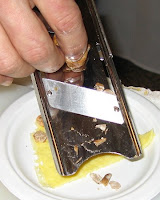 The fungus is scraped or grated onto food and into sauces and soups just before eating. Truffle slicers have been specially designed for this purpose. Experts recommend that veal, chicken, fish, soufflés, omelets, pasta, and rice can be glorified with thinly sliced truffles. Cream and cheese sauces avidly take up their flavor. Insert thin wedges of truffle under the skin of a chicken and store it overnight in the refrigerator before roasting. A well-known chef prepares a high-quality pâté de foie gras baked with a stainless steel tube running through the center. As soon as the pâté is cooked, he fills the tube with diced uncooked truffles and then removes the tube. Ok, I agree! OMG!
The fungus is scraped or grated onto food and into sauces and soups just before eating. Truffle slicers have been specially designed for this purpose. Experts recommend that veal, chicken, fish, soufflés, omelets, pasta, and rice can be glorified with thinly sliced truffles. Cream and cheese sauces avidly take up their flavor. Insert thin wedges of truffle under the skin of a chicken and store it overnight in the refrigerator before roasting. A well-known chef prepares a high-quality pâté de foie gras baked with a stainless steel tube running through the center. As soon as the pâté is cooked, he fills the tube with diced uncooked truffles and then removes the tube. Ok, I agree! OMG!
To keep and store truffles
The pungent odor of a truffle will penetrate the shells of eggs and flavor kernels of rice when stored with them in a closed glass jar, placed in a refrigerator. Once the prize truffle has been consumed, the eggs may be enjoyed in an omelet and the rice in pilaf.
Not cleaned to be used immediately:
Gently wash them with water and brush (best if with a vegetable brush, clean toothbrush or nail brush), and lightly pat dry with a paper towel.
Not cleaned, and stored:
Do not wash or brush until the day of use. To delay their ripening wrap in an absorbent paper towel or cloth, and store in the back or vegetable drawer of the refrigerator. Change the paper once a day. Alternatively, store in a jar of rice to absorb moisture and keep dry (plus the rice will absorb the truffle aroma and flavor, and will make a great risotto later).
If Cleaned:
Roll separately in an absorbent paper towel, paper bag, or absorbent cloth. Alternatively, store inside a jar or bag of rice. Change the paper towel every day, to absorb any moisture that may cause rot. Store in the back of the refrigerator or the vegetable drawer. Truffles can be frozen for two weeks in a freezer-proof glass jar. Another recommendation is to store them whole in bland oil.
Types of Truffles
Oregon white truffle (Tuber oregonense and T. gibbosum) Reasonably common in the Pacific Northwest from the west side of the Cascade Mountains to the coast from British Columbia to northern California. Tuber oregonense is generally found from October through February. Its exterior perideum is whitish when young, developing orangish-brown tints as it matures, and finally becoming orangish-brown overall. By February, most of the Tuber oregonense should be pretty mature and the T. gibbosum will just be getting started.
Reasonably common in the Pacific Northwest from the west side of the Cascade Mountains to the coast from British Columbia to northern California. Tuber oregonense is generally found from October through February. Its exterior perideum is whitish when young, developing orangish-brown tints as it matures, and finally becoming orangish-brown overall. By February, most of the Tuber oregonense should be pretty mature and the T. gibbosum will just be getting started.Oregon brown truffle (Leucangium brunneum)
 The Oregon brown truffle was discovered by NATS members in the early 1990's. It grows in younger Douglas-fir forests in the Oregon Coast Range and western foothills of the Cascades. It has a reddish-brown exterior and a greyish mottled interior. When mature the odor can be quite garlicky.
The Oregon brown truffle was discovered by NATS members in the early 1990's. It grows in younger Douglas-fir forests in the Oregon Coast Range and western foothills of the Cascades. It has a reddish-brown exterior and a greyish mottled interior. When mature the odor can be quite garlicky.Oregon black truffle (Leucangium carthusianum, formerly Picoa carthusiana)
Less common than Oregon white truffles, Oregon blacks are larger (golf-ball to baseball size), and are often much deeper in the soil than Oregon whites (commonly 4-10" deep). They are very dark inside and out, and have a very pungent, earthy odor when ripe. Some equate the aroma to a strange mix of pineapple, port, mushrooms, rich soil, and chocolate. Looking like irregular lumps of coal, with white-veined flesh, the Oregon black truffle has a texture of moist Parmesan and ground almonds.
Considered by some (mostly the French) to be second best to the French black truffles, its cost can exceed that of the perigord. It is native to the foothills and mountains of northern and central Italy and southern Yugoslavia. They grow in conjuction with oak, hazel, poplar, and beech trees. The flesh is solid, light-coloured, and very brittle; it is not unheard of for a fresh truffle to shatter if dropped on the floor. Large specimens can weigh as much as a pound, but most are the size of large walnuts. The white truffle is slightly more perishable than its darker cousins, and the flavor and aroma diminishes within a week or two after harvest. The white truffle has a distinctive pepper edge and is often eaten raw. The skin is a dirty beige when fresh, turning a darker brown with age.
Burgundy, or Summer truffle (Tuber aestivum, formerly Tuber uncinatum)
 Native to France, Italy, and Spain, the summer truffles are usually at their best in July, but can be found from May to October. They have a black exterior and off-white interior, and a relatively light scent. This truffle has been established on plantations in Sweden and New Zealand.
Native to France, Italy, and Spain, the summer truffles are usually at their best in July, but can be found from May to October. They have a black exterior and off-white interior, and a relatively light scent. This truffle has been established on plantations in Sweden and New Zealand. Tuscan truffle (Tuber borchii, formerly Tuber albidum)
Tuscan truffle (Tuber borchii, formerly Tuber albidum)Similar to the Italian white truffle in appearance, having a chestnut to muddy tan exterior and a softish interior equally divided between chocolate brown and white. The flavor can be distinctly garlicky.
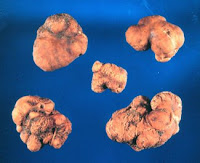 Pecan (Texas) truffle (Tuber lyonii, formerly Tuber texense)
Pecan (Texas) truffle (Tuber lyonii, formerly Tuber texense)Pecan truffles (also called Texas truffles) are found from New Mexico to the gulf coast and eastern seaboard to the great lakes and eastern Canada. It is not limited to areas with pecan trees, but was named based on the habitat in which it was discovered.
 Chinese truffles (Tuber sinense, Tuber indicum, and Tuber himalayense)
Chinese truffles (Tuber sinense, Tuber indicum, and Tuber himalayense)These are three distinct species found in South China, but pickers tend to lump them together as Chinese truffles. This is unfortunate since the flavor and quality vary from one species to another. First marketed in France in 1994, these truffles are now found in American restaurants at fairly reasonable prices, but their flavor and aroma do not come close to that of the French truffles, perhaps for the same reasons as Oregon white truffles (too many immature specimens). T. indicum is recognizable by its brown interior and very fine white veins. T. sinense has a dark brown interior with large ivory veins, and is said to be chewy and oily with a bitter aftertaste.
Desert truffles (Terfezia boudieri, Terfezia pfielii, Terfezia claveryi, and others)
Native to northern Africa and the Middle East, these truffles have been a staple for many nomadic tribes for millenia. Sometimes called the Lightning Truffle, they often fruit shortly after thunderstorms wet the desert.
Cultivation
 For many years, it was thought that truffles were simply to grow wild and man would never be able to tame this tuber. So convinced was Brillat-Savarin that he noted, "The most learned men have sought to ascertain the secret, and fancied they discovered the seed. Their promises, however, were vain, and no planting was ever followed by a harvest. This perhaps is all right, for as one of the great values of truffles is their dearness, perhaps they would be less highly esteemed if
For many years, it was thought that truffles were simply to grow wild and man would never be able to tame this tuber. So convinced was Brillat-Savarin that he noted, "The most learned men have sought to ascertain the secret, and fancied they discovered the seed. Their promises, however, were vain, and no planting was ever followed by a harvest. This perhaps is all right, for as one of the great values of truffles is their dearness, perhaps they would be less highly esteemed if  they were cheaper." Well much the expert that he was, he was also a bit of skeptic, critic and was known for his sarcastic wit. In this case however, he was to be proved wrong.
they were cheaper." Well much the expert that he was, he was also a bit of skeptic, critic and was known for his sarcastic wit. In this case however, he was to be proved wrong. As early as 1808, there were successful attempts to cultivate truffles, known in French as trufficulture. People had long observed that truffles were growing among the roots of certain trees, and in 1808, Joseph Talon, from Apt (département of Vaucluse) in southern France, had the idea to sow some acorns collected at the foot of oak trees known to host truffles in their root system.
 The experiment was successful: years later, truffles were found in the soil around the newly grown oak trees. In 1847, Auguste Rousseau of Carpentras (in Vaucluse) 17 acres of oak trees (again from acorns found on the soil around truffle-producing oak trees), and he subsequently obtained large harvests of truffles. These successful attempts were met with enthusiasm in southern France, which possessed the sweet limestone soils and dry hot weather that truffles need to grow. He received a prize at the 1855 World's Fair in Paris. In the late 19th century, two unrelated epidemics destroyed much of the vineyards and most of the silkworms in southern France, making the fields of mulberry trees useless. Thus, large tracts of land were set free for the cultivation of truffles. Thousands of truffle-producing trees were planted, and production reached peaks of hundreds of tons at the end of the 19th century. In 1890 there were 190,000 acres of truffle-producing trees.
The experiment was successful: years later, truffles were found in the soil around the newly grown oak trees. In 1847, Auguste Rousseau of Carpentras (in Vaucluse) 17 acres of oak trees (again from acorns found on the soil around truffle-producing oak trees), and he subsequently obtained large harvests of truffles. These successful attempts were met with enthusiasm in southern France, which possessed the sweet limestone soils and dry hot weather that truffles need to grow. He received a prize at the 1855 World's Fair in Paris. In the late 19th century, two unrelated epidemics destroyed much of the vineyards and most of the silkworms in southern France, making the fields of mulberry trees useless. Thus, large tracts of land were set free for the cultivation of truffles. Thousands of truffle-producing trees were planted, and production reached peaks of hundreds of tons at the end of the 19th century. In 1890 there were 190,000 acres of truffle-producing trees.In the 20th century however, with the growing industrialization of France and the subsequent rural exodus, many of these truffle fields (champs truffiers or truffières) returned to wilderness. The First World War also dealt a serious blow to the French countryside, killing 20% or more of the male working force. As a consequence of these events, newly acquired techniques of trufficulture were lost. Also, between the two world wars, the truffle fields planted in the 19th century stopped being productive. (The average life cycle of a truffle-producing tree is 30 years.) Consequently, after 1945 the production of truffles plummeted, and the prices have risen dramatically. In 1900, truffles were used by most people, and on many occasions. Today, they are a rare delicacy reserved for the rich, or used on very special occasions.
In the last 30 years, new attempts for mass production of truffles have been started. Eighty percent of the truffles now produced in France come from specially planted truffle-fields. Nonetheless, production has yet to recover its 1900s peaks. Local farmers are opposed to a return of mass production, which would decrease the price of truffles. It is estimated that the world market could absorb 50 times more truffles than France currently produces. There are now truffle-growing areas in the United States, Spain, Sweden, New Zealand, Australia, Chile, and the UK.
I hope you have enjoyed this look at the world of truffles. If you are lover of them, then today you have learned a little more about why. If you have never tried them, my suggestion is; the next time you see them on a menu, or on the shelf at your local gourmet food store, take the plunge and try them. I promise you won't be dissapointed. Hey, have I ever steered you wrong yet? Exactly! Viva la truffle!
Bon Appetit,
Sources:
www.whatscookingamerica.net,www.telegraph.co.uk,www.clubsauce.com/











